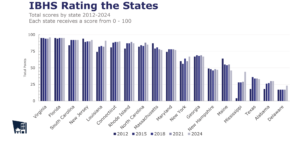Casualty is proving its value as a good diversifier for reinsurers, especially given the positive primary rate movement seen in recent years, according to an Aon report.
The combination of challenged property experience, robust primary casualty rate levels and thoughtful original limits management are making casualty a worthy diversifier for reinsurers, said the July edition of Aon’s “Reinsurance Market Outlook.”
The report provided a summary of themes that existed on many casualty renewals at July 2021, which included the following:
- The general casualty quota share market has been reinvigorated with new capacity as well as by many long-standing casualty reinsurers targeting growth given the current market conditions with hardening rates. However, despite continuing to support casualty quota shares in a meaningful way, some historically larger writers have taken a more cautious view on underlying trends that has limited desire for significant growth.
- Capacity for excess-of-loss programs is dependent on the performance of the program and not as readily available as support for proportional placements.
- Environmental capacity for pro rata remains strong, despite comparatively lower original rate increases than some other casualty lines. Excess-of-loss capacity is largely pricing dependent and less diversified.
- Professional liability has also seen a healthy increase in capacity available in the market. Improved ceding commissions and multi-year capacity are being achieved at renewals.
- Capacity exists for pro rata and excess-of-loss medical programs, though reinsurers remain cautious.
- Insurers are taking more of their pro rata placements net, bolstered by strong rate increases on the underlying business and greater comfort with reduced gross limits in their portfolio. Looking to future renewals, continued demand is likely for excess-of-loss and hybrid placements.
- Reinsurers continue to refine pricing methodology for lower layer excess-of-loss programs. Volatility in performance among programs has created more scrutiny on individual placements at these levels.
- One-off terms unique to reinsurers were able to be standardized in some cases given the capacity available in many casualty lines.
- Contagious disease is no longer the dominating discussion point with most markets.
- The London market is navigating the UK regulatory requirement for all re/insurance companies — both Lloyds and non-Lloyds — to have contractual clarity on cyber coverage/exclusion at July 1.
- Social inflation continues to be a concern for the reinsurance market, which is potentially compounded by legal case backlog-related pressures. Landmark casualty cases will resume working through the legal system and will test policy language. Given speculation around liability acceleration in a “post-COVID-19” environment where economic disparities seem to have increased, reinsurance remains a strong source of capital for insurers.
- The evaluation of liability accumulations is an increasing focus for insurers.
- While there are numerous emerging/emerged risks on the radar, opioids and PFAS continue to dominate discussions with wildfire remaining a central concern.
- Clash coverage remains available, despite a challenging year for some programs. New buyers are investigating traditional coverage and exploring non-traditional program design.
Aon’s Reinsurance Aggregate report analyzes the following companies: Alleghany, Arch, Argo, AXIS, Beazley, Everest Re, Fairfax, Hannover Re, Hiscox, Lancashire, Mapfre, Markel, Munich Re, QBE, Qatar Insurance, RenRe, SCOR, SiriusPoint, Swiss Re and W.R. Berkley.
Source: Aon
*This story ran previously in our sister publication Insurance Journal.





















 That Insurance Talent Crisis? It’s a Global Knowledge Opportunity
That Insurance Talent Crisis? It’s a Global Knowledge Opportunity  Uncertainty Keeps Prices Up; No Prior-Year Loss Development: Travelers
Uncertainty Keeps Prices Up; No Prior-Year Loss Development: Travelers  Travelers: Distracted Driving Incidents Continue to Rise
Travelers: Distracted Driving Incidents Continue to Rise  Former MLB Player Charged With Insurance Fraud in Florida
Former MLB Player Charged With Insurance Fraud in Florida 








